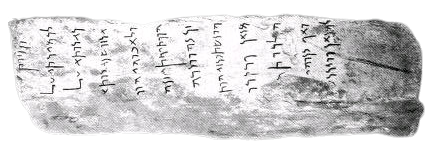During the Bar Kokhba Jewish revolt against Roman rule at the 1-2 century AD some coins were issued to commemorate it and the leader of the revolt Shimun Bar Kokhba.
One of them was a silver tetradrachm or Shekel coin issued at about the first half of the second century with inscriptions in the Paleo-Hebrew alphabet Aramaic language.
Hebrew was long gone a spoken language in the Holy Land. The spoken language was Aramaic which the Jews learned and shifted to after their exile to Babylon by the Persian Empire.
For more on the exile read When did the Jews shift to Aramaic?
First side reads Shimun as in Shimun Bar Kokhba- the head of the revolt.
At first I thought that the two symbols on the right denote a date but it turned out that the word Shimun is broken up in two parts far apart from each other.
Hence we got the letters
Shin, Mim, Vav, Nun
ŠMWN
Shimun
The flip side reads
LHRT YRŠLM
Leherut Yerushalem
Freedom to Jerusalem
Le- to,for
Herut- Freedom
Yerushalem- Jerusalem
LHRT
Leherut meaning to the freedom.
YRŠLM
Yod, Resh, Shin, Lamedh, Mim
YERUSHALEM
Jerusalem
Paleo-Hebrew vs Phoenician
The Paleo-Hebrew alphabet is essentially the Phoenician script. But the term Paleo-Hebrew came to be used because it was argued mainly by Jewish scholars that the script of the texts in area at that time cannot be called Phoenician.
This kind of coins is called Shekel.
שקל, plural שקלים sheqalim or shekels
From the verb root Š-Q-L meaning weight.



